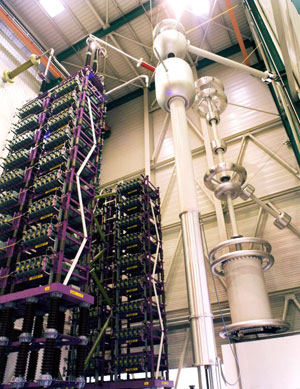 HVDC Supergrid Technologies Besting ExpectationsMar 27, 2013 - Peter Fairley - spectrum.ieee.org
An industrial research consortium that's a who's who of the European power industry says the development of technologies to produce high-voltage DC (HVDC) supergrids accelerated in 2012 and is "surpassing expectations." The assessment comes in the supergrids technology roadmap updated earlier this month by Friends of the Supergrid (FOSG), whose members include power equipment suppliers Siemens, ABB, and Alstom, as well as transmission system operators and renewable energy developers. Summarizing the conclusions of an expert group within the International Council on Large Electric Systems -- better known as CIGRE, its French acroynm -- FOSG says there is now no doubt as to the feasibility of HVDC networks ferrying renewable energy resources from wherever they are in surplus to wherever they are needed. "CIGRE Working Group B4–2 considered this question, specifically whether it was technically and economically feasible to build a DC Grid, and the answer was yes," wrote FOSG. The FOSG supergrid roadmap notes accelerated progress in several core HVDC components. Research enabling use of a broader range of subsea and underground HVDC cables is expanding the supplier base for supergrid lines. Another core technology moving fast is the voltage source converter (VSC) variant of AC to DC converters that connect HVDC lines with the AC grid. VSCs make today's HVDC lines dramatically better than "classical" HVDC technology. Though HVDC has long excelled at moving high power over long distances, classical HVDC is an unlikely candidate for meshed DC grids because it must reverse the polarity of a line to reverse its current. VSC technology is more flexible, and has recently begun to enable groundbreaking multi-terminal HVDC projects. Sweden's South-West Link, for example, is expected to open next year with three terminals; a fourth converter is to extend the line to Norway by 2018. Also noted in the FOSG roadmap are recent developments in VSC converters that make them capable of breaking HVDC current. Among them are theadvanced VSC converter tested by Alstom in February (see photo), and thehybrid electro-mechanical breaker announced by ABB in November. FOSG chairman Marcello del Brenna, who is also CEO of Italian high-voltage cable manufacturer Prysmian PowerLink, asserts that within this decade, European grid operators will begin to cobble together HVDC lines to form the world's first meshed HVDC network. It will ultimately interconnect North Sea wind farms, Mediterranean solar plants and Scandinavian hydropower. That is, says del Brenna, if policies are in place to drive it forward. He called on European Union policy makers to eliminate barriers to a truly integrated power market, and to "put in place the regulatory framework to enable large scale interconnection" between its members. Interconnection is a longstanding problem, but one that has undergone some recent remediation. In 2008, the European Commission brought in Mario Monti—the former EC competition commissioner who more recently served as Italy's prime minister—to secure a critically-needed link between France and Spain. The link had been stalled for 15 years. Next year, however, it's slated to start up, with two HVDC cables driven by the world's first gigawatt-scale VSC-based converters. Photo: Alstom |
